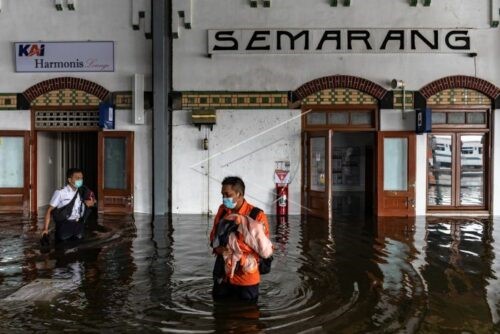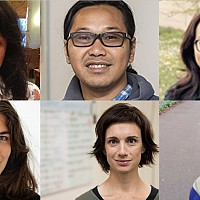Flood in Semarang and three alternative solutions
Re-posted from FLOWs, the Water Governance Blog at IHE Delft Institute for Water Education
Semarang, one of the largest cities in Indonesia, is currently hit by the worst flood of the last ten years. The response by the Government relies on giant flood infrastructure. In this collective piece Amalinda Savirani (Universitas Gadjah Mada), Bosman Batubara (University of Amsterdam), Marie Belland (University of Amsterdam), Michelle Kooy (IHE Delft Institute for Water Education), Nila Ardhiani Amrta (Amrta Institute for Water Literacy) and Wigke Capri (Universitas Gadjah Mada) suggest three alternative solutions on the basis of their research “GroundUp: A practice-based analysis of groundwater governance for integrated urban water resource”.

Worker rescues a number of items from the flooded office at Tawang train station, Semarang, Central Java, Saturday (6/2/2021). Due to flood up to 70 cm of water column the regional train office/company changed a number of train routes. ANTARA FOTO/Aji Styawan/wsj.
Semarang is currently experiencing the worst flood event of the last ten years. Flood management infrastructure used to control water flow through the city, the solution for many years, can no longer reduce flood risk for the city’s residents. The flood event starting on 5 February 2021 has severely disrupted the city and the province’s transportation systems, with two rail stations (Tawang, Poncol), the airport, and the northern highway (Pantura) either closed, or severely incapacitated. While 972 residents had to evacuate their homes, many more report severe flood damage, particularly the northern neighbourhoods of Tambakregio and Genuk.
Responding to the emergency flood situation in Semarang, the Governor of Central Java said that the Provincial government is unable to intervene to mitigate the impact, while the Ministry of General Works and Housing blames the city’s flood vulnerability on natural causes: it is due to “extreme weather”. The city’s residents – especially the lowest income groups living in the lowest lying neighbourhoods by the coast, or next to rivers and canals – are left to cope as best they can, as they did with previous flood events over the city’s history.
The ‘naturalness’ of this flood event, and the reliance on infrastructure to reduce flood risk, is something we question. Our research project has set out to document how this and other flood events in Semarang are not ‘natural’ – but rather are directly related to the current choices and actions of the government, residents, and the process through which the city has developed in the past. Our project, “GroundUp: A practice-based analysis of groundwater governance for integrated urban water resource” supported by Ristek DIKTI and the Dutch Research Council (NWO), is examining how society – the social – has shaped and been shaped by the city’s water flows. We ask what this means for how the costs and benefits of the city’s development and changing relationship with water are distributed unevenly through the population. Today’s flooding in Semarang is the product of a particular relationship between society and water; shaped by particular societal choices and urban development processes. We argue different choices about both water management and society can and must be made in order to provide an ecologically sustainable and socially equitable future for the city. Our project highlights two areas for attention.
Slow land subsidence through reduction of groundwater extraction
Land subsidence, 19 cm/year in some areas of Semarang, increases vulnerability to tidal flooding and coastal erosion. Research documents the abstraction of groundwater as one key factor in the soil compaction and sinking of the city. And yet – knowing this relationship, the city remains highly dependent on groundwater for its water supply. Often, residents have no choice but to dig deep wells, as the water provided by the public water supply company is unavailable: the network covers less than 70% of the city area, and data from state regulators of water service provision from units at Ministry of General Works and Housing, report unreliable quality and continuity of water supply in the network.
Our recent household survey documenting access to water reveals the significance of groundwater use. Of 319 households, covering 10 districts/kecamatan and 21 sub-districts/kelurahan in Semarang City, 49% depend on deep wells for clean water, 30% from shallow water, 20% from PDAM (Perusahaan Daerah Air Minum, the municipal water company), and 1% use river water. Households relying on groundwater report well depths of 50-100m, meaning groundwater comes from the contained aquifer, where over-abstraction is linked to land subsidence. In our survey, even in areas of the city where public water supply is available (Kelurahan Kuningan), more than half of the respondents still consume the groundwater for daily needs. Even more significant than household use is the reliance on groundwater by commercial and industrial users.
Giant infrastructure for flood resilience: problem or solution?
Stopping groundwater extraction by expanding the public water supply network – and improving surface water treatment to improve quality of supply – would be one long term solution to Semarang’s flood vulnerability. And yet, this seems to be far less of a priority for government investment than supporting the development of large infrastructure for private sector development. Construction on a giant seawall, topped by a 27 km toll-road project, began in 2019 as a ‘national strategic project’. The city’s flood infrastructure is part of a the development of an economic corridor across Java, costing IDR 15,3 trillion (almost USD 1.1 million).

Sinking pumping house in Semarang River (Credits: Ground Up)

In 2012, the bottom part of the outflow had a 1 m distance from sea level which now touches it (Credits: Ground Up)
Our project asks what water problems will this project actually solve, and for whom? The seawall and the network of drainage channels protect only part of the city’s coastal area, leaving lower income northern neighourhoods unprotected, or evicted. This solution is also heavily dependent on pumping, while the functionality of existing pump infrastructure is limited – pump houses are also flooded and/or sinking (see pictures). Meanwhile the giant infrastructure of seawall and toll road can further increase land subsidence, adding additional weight on the sediment of North Semarang. Could this infrastructural solution cause more land subsidence and put all Semarang population at risk due to both tidal and river flooding?
Three alternative solutions
Based on our ongoing research and preliminary findings, we suggest the opening up of alternative solutions for transforming the relationship between water and society for more just and ecologically sustainable futures. First, reduce the use of groundwater in Semarang. To do this, it is urgent for the government to support water supply installation (piping) to reach all of the city’s residents, and apply a strict regulation to prohibit the use of groundwater. While this is crucial, the recent omnibus law on water sector, tend to be open for investment in this sector. Second, recognize the limitations of large infrastructure solutions and open up the impacts of these investments for societal debate: who and what is being protected, and at what cost of others? Third, our research shows the significance of urban residents in water governance: decisions and actions shaping the distribution of surface and groundwater throughout the city are not only the purview of state authorities. Caring for water, for local environments, and for each other emerges as priorities motivating resident-led development of groundwater conservation and flood management practices. We hope these are also the priorities motivating the collective identification and participatory development of just and sustainable flood management interventions of the Indonesian state.
The project “GroundUp: A practice-based analysis of groundwater governance for integrated urban water resource” is supported by Ristek DIKTI (Indonesia) and by the Dutch Research Council (NWO). It aims at understanding the socio-ecological and socio-technical relations between surface water and groundwater.
FLOWs is the Water Governance Blog at IHE Delft Institute for Water Education.





